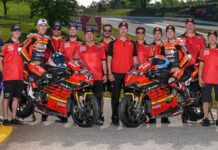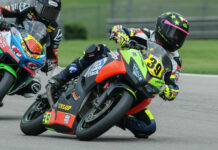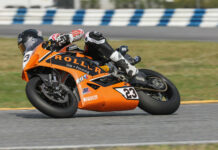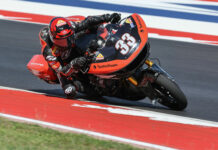From a press release issued by Ducati Corsa:
French Grand Prix, Le Mans
May 23/24/25 2003
DUCATI MARLBORO MEN AIM TO CONTINUE AMAZING FORM
The 2003 MotoGP World Championship reaches one-quarter distance in France this weekend, the Ducati Marlboro Team having already firmly established itself as a major player in the series.
Following history-making performances at the first three GPs – including Ducati’s first-ever pole position in Grand Prix racing’s premier class – riders Troy Bayliss and Loris Capirossi come to France aiming to continue their remarkable progress with the amazing Ducati Desmosedici. The machine has already led the Japanese, Africa’s and Spanish GPs, and its astoundingly powerful engine will be vital at Le Mans, where acceleration is one of the most crucial performance factors.
After Le Mans the MotoGP circus moves to Italy for the Ducati Marlboro Team’s home Grand Prix at Mugello. The 16-event 2003 season concludes at Valencia, Spain, on November 2.
LE MANS – ANOTHER UNKNOWN QUANTITY
It has taken just three races for Ducati Marlboro Team riders Troy Bayliss and Loris Capirossi to prove the performance of the Desmosedici. Indeed the Australian and Italian have grabbed the headlines wherever they’ve been on the 220-plus horsepower V4.
During preseason testing the machine recorded the fastest top speed ever achieved by a GP bike – 328.2kmh/203.9mph – then at April’s season-opening Japanese GP Capirossi gave the bike a podium finish in its race debut. Three weeks later in South Africa he put it on the front row for the first time and a fortnight ago in Spain he made history by giving the legendary Italian marque its first MotoGP pole. Bayliss qualified second at Jerez, just one hundredth of a second slower and went on to score his first GP podium finish to put himself third in the points chase. Ducati currently lie second in the manufacturers’ World Championship, a position that belies the marque’s ‘rookie’ status in MotoGP.
But this weekend’s French GP won’t be an easy event for the Ducati Marlboro Team. Many of the Bologna-based crew have never even seen the legendary Le Mans circuit, so they will start from zero on Friday morning.
“We’ve never been to Le Mans, just like we’d never been to Welkom when we went to South Africa,” says Ducati Marlboro Team director Livio Suppo. “But the first three races seem to tell us that the bike does adapt well from one track to another.
“We’ve been under a lot of pressure these last few months, working very hard during the winter, but I think we can now say that we are at a good level. Of course, you’re never happy – at Jerez we had an amazing Saturday, qualifying first and second, but Sunday wasn’t so great, even if a podium finish is a good result for a young team. Despite the pressure there’s a great atmosphere in our pit – everyone’s happy.”
Ducati Marlboro Team technical director Corrado Cecchinelli also expects a challenging Le Mans weekend, but is confident that the Desmosedici will perform well at a track that places the emphasis on straight-line acceleration and braking stability.
“Our bike’s acceleration looks good compared to other machines – we don’t have a problem with absolute performance,” he says. “But our main concern is to find a set-up balance that allows our riders to achieve optimum performance over race distance, rather than for one or two laps. It’s a matter of finding the right compromise between stability, so the rider feels relaxed, and handling, so the rider needs less effort to go fast. These factors are pretty much mutually exclusive – improving one of them often adversely affects the other – so it’s just a case of finding the right balance.”
BAYLISS MAKES HIS FRENCH RACE DEBUT
Troy Bayliss has been a world-class rider since he started his full-time World Superbike career in 2000, but he has yet to race in France. This weekend the Ducati Marlboro Team man therefore gets his first chance to show French fans his hugely entertaining riding style. World Superbike champ in 2001, Bayliss has an all-action riding technique that is proving perfectly suited to the task of controlling a 220-plus horsepower MotoGP bike.
The Aussie gets faster and more competitive with every outing on the Desmosedici, his results describing a perfect upward trend – fifth in Japan, fourth in South Africa and third in Spain two weeks ago. As Ducati boss Federico Minoli joked at Jerez: at this rate Bayliss should win next month’s Italian GP! Of course, Bayliss’ down-to-earth attitude won’t let him talk of such things just yet, all he’s concerned with right now is continuing to improve his equipment.
“I’m fairly happy with progress but you’re always looking for something more in racing,” he says. “So we’ve got to keep kicking and see how things pan out. I know nothing about Le Mans, except what I’ve learned by watching video tapes of last year’s race, so we’ll just go there and do what we can do. With the horsepower we’ve got it shouldn’t be bad, and I don’t have any major problems going on with the rest of the bike.”
Bayliss has quickly settled into life in the MotoGP paddock after three years on the World Superbike trail. “I’m enjoying it and the kids are having a good time,” says Bayliss, who travels to races with wife Kim, son Mitchell and daughter Abbey. “They’ve made friends with Jeremy McWilliams’ kids, having water-bomb fights, that kind of thing!”
CAPIROSSI LOOKS FORWARD TO MORE POINTS
Loris Capirossi aims to put his unlucky Spanish GP experience behind him this weekend when he brings his lightning-quick Ducati Marlboro Team Desmosedici to Le Mans for the first time.
So far this year Capirossi has proved himself to be one of the fastest riders on the grid – scoring his first MotoGP pole at Jerez two weeks ago and leading both the Japanese and Spanish GPs. But he was out of luck in Spain and South Africa, recording DNFs in both races. He led at Jerez, then crashed, struggling to control his machine after it had been damaged in a warm-up lap incident. And at Welkom he was caught out by oil that had been spilt by another bike, twice running off the track.
“What happened at Jerez was unlucky, but at least I wasn’t badly hurt in the crash,” says Capirossi, who banged his left arm so badly that he initially thought he had broken a bone. “I’m not happy to have scored zero points from the last two races, so I badly want a good result at Le Mans. As usual, I shall be aiming for the podium.
“I have to say that Le Mans isn’t one of my favourite circuits. I’ve won a 250 GP there (way back in 1994) but I’ve never really enjoyed it since I moved to the big class. It’s not a bad track, but it’s not so interesting for riders – it’s just accelerate, brake, accelerate, brake, accelerate… The good thing is that we have a lot of horsepower, which will be very useful coming out of the slow corners, but we still need to do some more work on braking stability.”
THE TRACK
Legendary for its 24-hour races, Le Mans has been hosting World Championship GPs on and off since 1969. The Bugatti circuit, very different from the longer 24-hour car track, returned to the GP calendar in 1999, since when the event has built a huge following in bike-mad France.
Le Mans has undergone various layout changes and safety modifications over the past few years. The daunting high-speed first turn was tightened for the ’99 GP and the Musee left-hander was also modified to lower speeds. Further modifications were carried out before last year’s event.
The track’s character is very stop-and-go, with plenty of slow turns where braking and acceleration performance are primordial. Riders and their engineers therefore concentrate on honing their machines’ braking stability, as well as improving rear-end traction for the numerous hairpin exits.
Le Mans: 4.180km/2.597 miles
Lap record: Valentino Rossi (Honda) 1:36.846, 155.380kmh/96.549mph
Pole position 2002: Rossi 1:36.046
DUCATI MARLBORO TEAM DATA LOGS
TROY BAYLISS
Age: 34
Lives: Monaco
Bike: Ducati Marlboro Team Desmosedici
First GP: Australia, 1997 (250)
GP starts: 4 (3xMotoGP, 1×250)
World Superbike victories: 22
World Championships: 1 (Superbike: 2001)
Le Mans 2002 results: DNS
LORIS CAPIROSSI
Age: 30
Lives: Monaco
Bike: Ducati Marlboro Team Desmosedici
GP victories: 22 (2×500, 12×250, 8×125)
First GP victory: Britain, 1990 (125)
First GP: Japan, 1990 (125)
GP starts: 187 (17xMotoGP, 59×500, 84×250, 27×125)
Pole positions: 34 (1xMotoGP, 5×500, 23×250, 5×125)
First pole: Australia, 1991 (125)
World Championships: 3 (125: 1990, 1991, 250: 1998)
Le Mans 2002 results. Grid: 7th. Race: 7th
More, from a press release issued by Team Suzuki News Service:
IMPROVING SUZUKI’S NEW TEST AT LE MANS
Next Sunday’s French GP – fourth of 16 rounds in the World Championship – poses a different sort of challenge to the all-new Suzuki GSV-R and riders Kenny Roberts Jr. and John Hopkins at the slow, tight, and twisty Le Mans circuit.
Last year, Roberts was fifth … his best of the first half of the season. There are better omens still this year, after team-mate Hopkins took the fast-developing new machine to its best result so far this year with a gritty ride to seventh at the Spanish GP at Jerez. That race was followed by an intensive three days of testing at the Catalunya GP circuit.
The French track has a different character to the technical Spanish circuits, and asks different questions of machine and riders. The first question for Suzuki is whether the benefits felt in Spain will still be valid at Le Mans. And French motorcycling legend Jean Michel Bayle will be at the race to help them find the answers.
The 2003 version of Suzuki’s 990cc V4 MotoGP racer is completely redesigned compared with last year’s first prototype, and represents a distinct step forward in technology. The potential was obvious from the first time the team saw the machine in January. Until now, however, the new motorcycle has lacked that final edge that would allow Roberts and Hopkins to be fully competitive with the best of the rest for the full race distance.
Suzuki’s dedicated racing department, enjoying widespread success in other forms of racing, is hard at work to find the right technical balance that will unleash the GSV-R’s full potential. The factory’s fast-forward development programme saw factory riders Ryo and Akioshi as well as ex-motocross multi-champion and former GP racer Bayle test for three days at Catalunya, joined by Roberts and Hopkins for the last two days.
Yet more testing is planned for the day after the French GP, with Bayle again taking to the saddle at the circuit where he was second in a Suzuki Endurance Racing Team (SERT) one-two in the recent 24-hour race.
“Le Mans is a difficult track, and this is the most competitive GP season ever. But we will be going there to build on the growing confidence and commitment within both the team and the factory racing staff,” said Team Manager Garry Taylor.
“Our tests at Catalunya were very productive, and we’re making progress all the time towards our goal, of racing up at the front again as soon as possible.
“John gave us an inkling of it at Jerez, and Kenny would have done better there too if not for his poor starting position … and that was through a team mistake during qualifying,” Taylor continued.
“The help from Jean Michel has also been very positive. He will be at Le Mans as an observer during the race, and will be testing again with our two riders on the next day.”
Suzuki’s GSV-R is one of seven different makes of machine fighting for victory in the second year of the four-stroke MotoGP class, and the Suzuki pair have finished in the points in all three races so far. The fourth race, second in the European season, follows the Spanish start with a trip to the west of France, where colder weather and even rain might be an added complication at the tight Bugatti circuit.
The growing popularity of MotoGP racing means that big crowds can be expected at the legendary motor sport venue. The next round in the 16-race calendar is the Italian GP, in two weeks.
KENNY ROBERTS Jr.: CHECKING THE LEVELS – We have some stuff from the test that needs more time before we’ll know if the benefits we found in Catalunya will also be benefits at Le Mans. All the stuff I want to try has to do with the engine. All the four-strokes have started to develop so rapidly now, and we need to improve. Le Mans has a lot of slow corners with short drag strip straights where you accelerate hard, and that’s one area we need to work on.
JOHN HOPKINS: BETTER EVERY TIME – This is my first season in the factory team, and I’m taking it one step at a time, race by race. We’re getting the bike better almost every time we go out, so we have to keep on that direction, and I’ll be ready to make the most of my chances. Le Mans is a fun track, and I’m looking forward to seeing how well we can do.
ABOUT THIS RACE – The French GP is a long-standing but irregular fixture on the calendar. The first event was run in 1951, the third year of GP racing – but in the 50 years since there have been just 37 events under that name. The GP has wandered around the country, moving from the first event at Albi to Rouen, Reims, Clermont Ferrand, Le Castellet, Nogaro and Magny-Cours over the years. the first time at Le Mans was in 1969, on an early version of the then-new Bugatti circuit, which uses only the traditional pits and start-finish area of the famous 24-hour car track Since that time the circuit has been changed considerably in detail, even since the last series ended in 1995; while the French GP moved down south again to Le Castellet. The return to Le Mans in 2000, after the southern circuit was decommissioned, signaled a revival of crowd numbers at the venue.
ABOUT THIS TRACK – The Bugatti circuit originally used part of the famous Sarthe 24-hour car circuit – the pit straight and a daunting right-hand corner under the Dunlop bridge and down the hill – before looping off for the first of its U-turns and short straights. The first change was to put a slow chicane before the bridge. Last year a second major alteration dealt with the exit from the bridge, carrying the track further to the left and making the first U-turn into a much faster and more sweeping corner. The short following straight reasserts the track’s character: hard acceleration followed by hard braking for the Museum U-turn, then another in the opposite direction before the short back straight and more slow corners leading back to the final hairpin. It makes for a slow average speeds, and Le Mans is one of the four slowest circuits on the calendar.
GP DATA
Bugatti Circuit – Le Mans
Circuit Length: 2.597 miles / 4.180 km
Lap Record: 1:36.846 – 96.549 mph / 155.380 km/h. V Rossi (Honda) 2002
2002 Race Winner: V Rossi (Honda)
2002 Race Average: 34:22.335 – 95.211 mph / 153.228 km/h (race shortened)
2002 Fastest Race Lap: see lap record
2002 Pole Position: Rossi 1:36.046
2002 Kenny Roberts: Fifth, qualified Ninth (Telefónica MoviStar Suzuki)
2002 J Hopkins: 11th, qualified 19th (Yamaha YZR500)
More, from a press release issued by Pramac Honda Racing Information:
FOURTH ROUND OF WORLD CHAMPIOSHIP IN FRENCH CITY OF MOTORS
The fourth race of the 2003 World Championship will be battled out on the historic Le Mans circuit, at the very heart of French motoring: the city of Le Mans. The Bugatti circuit, made in 1965, in the same area as the memorable 24-Hours track, hosted its first motorcycling races in the late 960s. After making their debut, motorcycles did not return to the circuit fr a long time as the layout was completely overhauled in order to bring it into line with the latest safety regulations. Restructuring work started in 1995 and made the circuit perfectly suited to the power that modern machines are now able to unleash. In 2000, the MotoGP made its grand return. The facilities are now fantastic, capable of holding over 100,000 spectators. This is the venue not only for the World Road Racing Championship but also for the Formula 3000 FIA, the French Touring championship and the Gran Turismo championship.
The circuit, which is located 5 km south of the town of Le Mans and 200 from Paris, has some very particular features, including a number of corners that racing bikes have to take in first gear, shutting off the throttle at the very last moment and braking very hard, followed by rapid acceleration that severely tests the ability of the bike to deliver its engine power down to the ground. This circuit is by no means easy to interpret and will put most technicians and riders to a very difficult test. And of course there is one important variable – weather conditions – that in this part of France really can make the difference.
THE CIRCUIT: 4,180 metres – lefthanders: 4 – righthanders: 9 – longest straight: 450 metres – maximum width: 13 metres.
WINNER IN 2002: 125 class: Cecchinello (ITA) Aprilia – 250 class: Nieto (SPA) Aprilia – 500 class: Rossi (ITA) HONDA.
CIRCUIT RECORDS: 125 class: Azuma 1:44.259 (2002- HONDA) – 250 class: Melandri 1:39.648 – (2002 – Aprilia) – 500 class: Rossi 1:36.846 (2002 –
HONDA).
MAX BIAGGI AND CAMEL PRAMAC PONS TEAM MAKE THIRD CONSECUTIVE PODIUM
Max Biaggi makes another very important podium position For the third time in three races, the four-times world champion has been up on the rostrum. With two second places and one third, Massimiliano Biaggi is keeping his grip firmly on second place in the ratings, with a 56-point lead and just 14 from the leader. The Pramac colours are also being held high by his teammate Tohru Ukawa in the CAMEL PRAMAC PONS TEAM, who came fourth in the recent race at Jerez, thus making sixth place in the overall world championship ratings with 23 points.
MAKOTO TAMADA (PRAMAC HONDA TEAM) SIXTH AT JEREZ
Makoto Tamada comes to this important Le Mans rendezvous with even greater motivation. His recent, very positive result at Jerez de la Frontera has given this brilliant Japanese rider a powerful injection of energy. In Spain, Makoto rode a great race, showing off all his potential and the remarkable progress made by Japanese tyre manufacturer Bridgestone. Having been up in fourth place for three laps, Tamada then let Barros and Ukawa by, ending up sixth, but his performance in the central part of the race showed how he is quite undaunted by better-known adversaries he is now taking on in his first MotoGP season.
In theory, the characteristics of the Le Mans circuit should suit the style of the young Japanese rider. His skill in braking, and his aggressive way of handling 180-degree corners could come to the fore on the particular layout of the French track.
As always, Tamada will have little time to get to grips with the circuit and find the right solutions for the race. Tomorrow he will be seeing Le Mans for the first time and on Friday and Saturday he will have to get through an enormous amount of work: perfecting the set-up of his RC211V and then finding the right choice of tyres. Working on the data acquired during the Jerez race, Bridgestone will provide him with new materials specially designed for the French track.
More MotoGP Teams Preview LeMans
More MotoGP Teams Preview LeMans
© 2003, Roadracing World Publishing, Inc.






